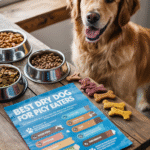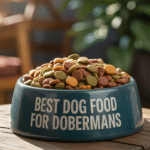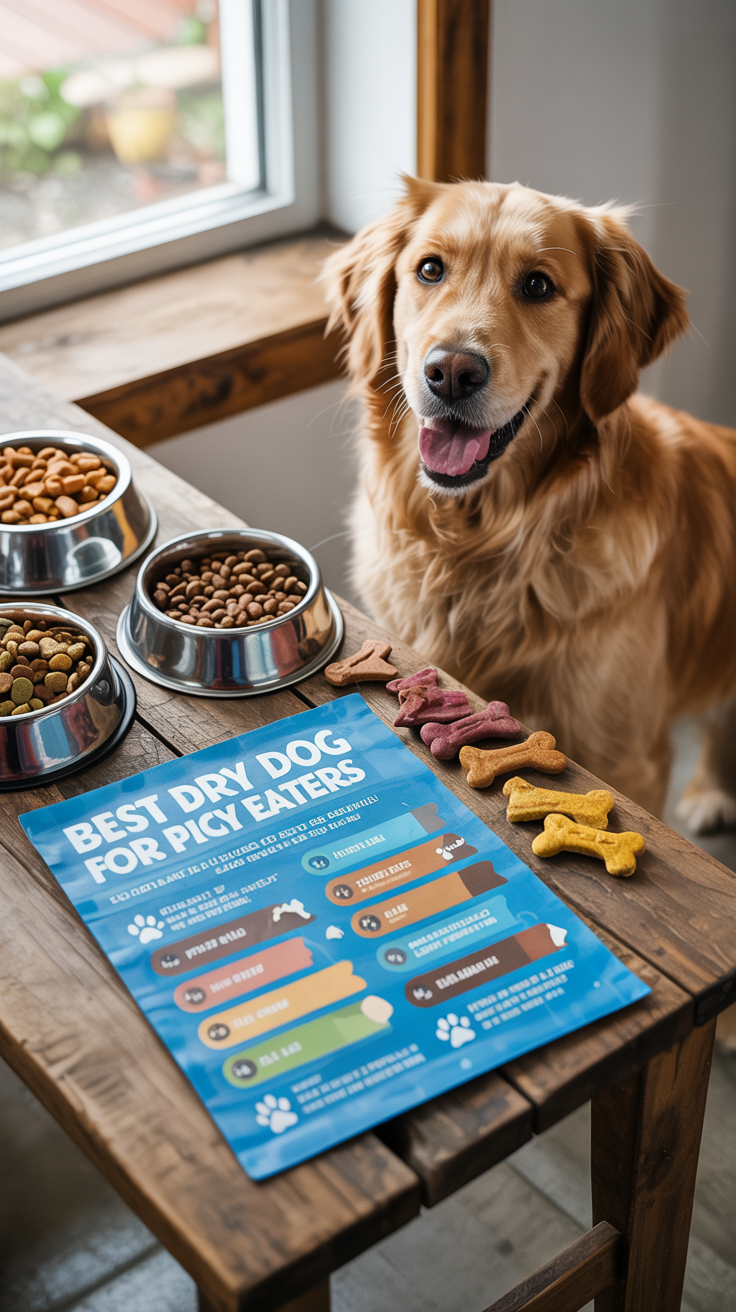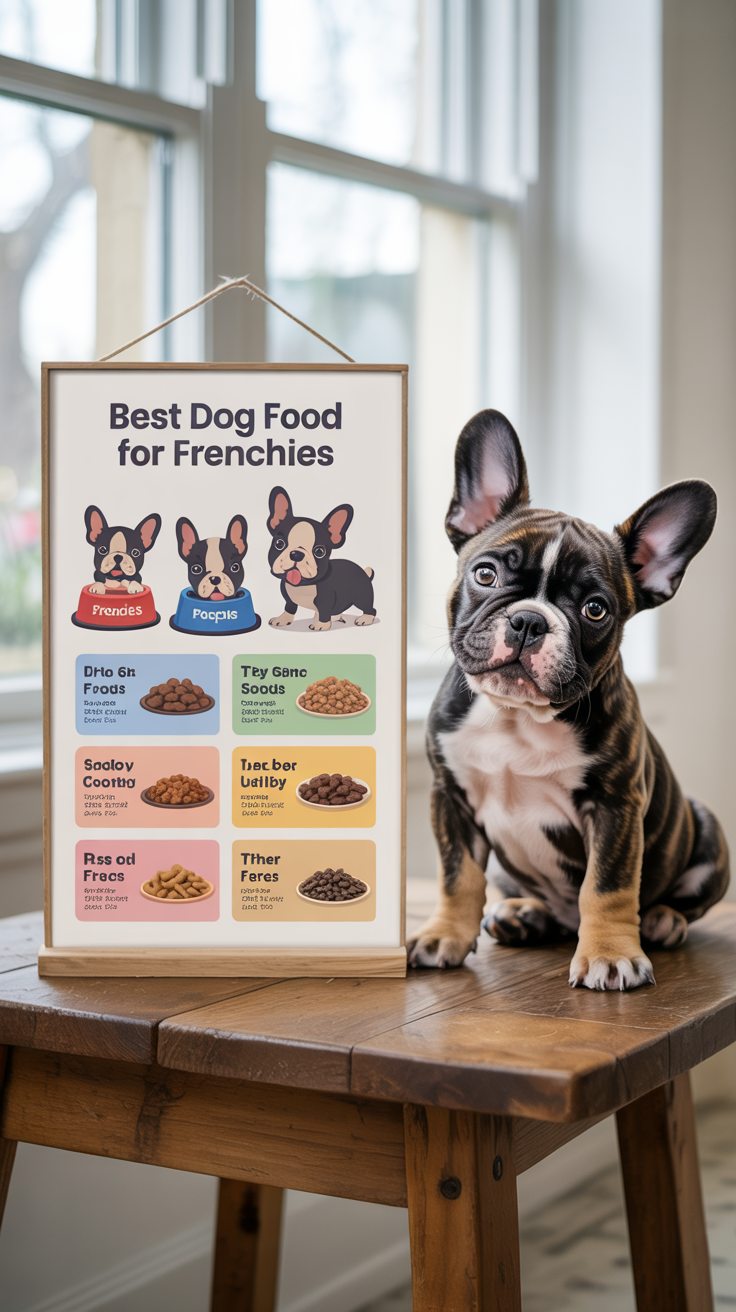Understanding Why Your Dog Doesn’t Want to Eat
As a pet owner, it can be concerning when your dog doesn’t want to eat. A sudden change in appetite may indicate underlying health issues or behavioral concerns. Understanding the reasons behind your dog’s loss of appetite can help you address the issue and get them back on track.
One common reason your dog may not want to eat is health-related. Dogs can experience a range of medical conditions that affect their appetite, including:
- Dental problems: Issues like tooth decay, gum disease, or broken teeth can make eating painful. A vet checkup is essential if you suspect dental issues.
- Digestive disorders: Conditions such as gastritis or pancreatitis can lead to nausea, causing your dog to avoid food.
- Infections: Both viral and bacterial infections can cause a dog to lose its appetite. If your dog shows signs of lethargy or other symptoms, consult your veterinarian.
- Chronic illnesses: Diseases such as kidney disease or liver problems can result in decreased appetite as well.
If your dog suddenly stops eating, it’s important to monitor other behaviors. Look for signs such as lethargy, vomiting, diarrhea, or changes in drinking habits. Contact your veterinarian if you see any red flags. They can perform necessary tests and evaluations.
Another reason your dog doesn’t want to eat may be stress or anxiety. Dogs can be sensitive to changes in their environment, which can affect their eating habits. Consider the following factors:
- New surroundings: Moving homes or altering their routine might cause anxiety, leading to a lack of appetite.
- Separation anxiety: Dogs may refuse to eat when they feel anxious about being separated from their owners.
- Family changes: An addition to the family (a new baby or pet) or the loss of a loved one can affect your dog’s emotional well-being and eating habits.
Creating a calm and stable environment can help alleviate anxiety-related eating problems. Maintain a consistent feeding schedule, and consider utilizing puzzle toys to engage your dog’s mind during meals.
Sometimes, your dog’s reluctance to eat may simply be due to pickiness. Dogs, like humans, can develop food preferences. Here’s how to make meal times more appealing to your furry friend:
- Introduce variety: Mix up their diet with different proteins, vegetables, and grains. Feeding them a high-quality diet with diverse options can boost their enthusiasm for eating.
- Enhance taste: Adding a bit of low-sodium broth or tasty toppings can entice even the pickiest eaters.
- Check food freshness: Stale or spoiled food can deter dogs from eating. Always ensure that you provide fresh, high-quality food.
Another potential factor is the temperature of the food. Some dogs prefer their meals warmed slightly, while others might enjoy their food cold. Experimenting with different temperatures may help you find what works best for your dog.
Don’t overlook the potential for overeating prior to the sudden lack of interest in food. If your dog has been indulging in too many treats or is consuming too much food during feeding, they may simply not feel hungry. Look for signs of obesity, which can also lead to more serious health issues down the line. Consider implementing a feeding schedule and monitoring treats to avoid overindulgence.
If you’ve tried various strategies and your dog still doesn’t want to eat, it’s time to consult a veterinarian. They can help determine if there’s an underlying medical issue or provide tailored advice based on your dog’s specific situation.
Understanding why your dog doesn’t eat can involve exploring health issues, behavioral changes, or even dietary preferences. Always prioritize your dog’s health and well-being, and don’t hesitate to seek professional help.
For further information on dog health and nutrition, check out The American Kennel Club and PetMD for more insights.
Common Health Issues That Affect a Dog’s Appetite
As a dog owner, it’s concerning when you notice your furry friend is not as enthusiastic about their meals. Several health issues can lead to a decrease in appetite. Understanding these problems can help you better support your pet’s well-being. Here are some common health issues that can affect a dog’s appetite:
Dental Disease
Many dogs suffer from dental issues as they age. Dental disease, which includes gingivitis and periodontal disease, can cause pain and discomfort while eating. If your dog is having trouble chewing or seems to intentionally avoid food, dental health may be a factor. Regular vet visits for dental cleanings can help prevent these issues.
Gastrointestinal Problems
Gastrointestinal issues like nausea, inflammatory bowel disease, or pancreatitis can significantly affect your dog’s appetite. Signs of gastrointestinal distress may include vomiting, diarrhea, or bloating. If your dog shows these symptoms and refuses to eat, consult your veterinarian promptly.
Infections and Illnesses
Infections such as kennel cough, canine parvovirus, or even the common cold can make your dog feel lethargic and reduce their desire to eat. Systemic infections can cause inflammation, fever, and discomfort, making food unappealing. A quick trip to the vet is essential if you notice any additional symptoms.
Kidney Disease
As dogs age, kidney function can start to decline. Kidney disease can cause a lack of appetite, excessive drinking, and changes in urination. If you suspect your dog is experiencing kidney issues, bring them to the vet for a blood test, as early detection can help manage the disease effectively.
Liver Problems
Liver diseases in dogs can manifest through loss of appetite, vomiting, and jaundice. Due to the liver’s role in detoxifying the body and food metabolism, any dysfunction can lead to significant changes in eating behavior. A comprehensive veterinary examination can help determine liver health through blood work and imaging.
Stress and Anxiety
Just like humans, dogs can experience stress and anxiety. Changes in their routine, moving homes, or the introduction of new pets can trigger these feelings. An anxious dog may refuse to eat or eat less than usual. To counteract stress, create a calm environment and maintain a consistent routine. Behaviorists can also help if anxiety persists.
Age-related Changes
Older dogs often experience a myriad of health changes that may influence their appetite. Arthritis and other age-related conditions can cause pain and discomfort, making the act of eating less appealing. Additionally, some older dogs may develop decreased senses, making food less enticing. Keeping their diet suitable for seniors and considering flavor and texture can help retain their interest in meals.
Medications
Certain medications may cause a decrease in appetite as a side effect. If you’ve recently started your dog on a new medication and noticed reluctance to eat, consult with your vet. They might adjust the dosage or suggest an alternative medication.
Recognizing and addressing the underlying health issues affecting your dog’s appetite is crucial. If your dog refuses food for more than 24 hours, consult your veterinarian for proper diagnosis and treatment options.
Table of Common Health Issues Related to Dog’s Appetite
| Health Issue | Symptoms | Veterinary Action |
|---|---|---|
| Dental Disease | Pawing at mouth, reluctance to chew | Dental examination and cleaning |
| Gastrointestinal Problems | Vomiting, diarrhea, bloating | Diagnostic tests and dietary changes |
| Infections | Lethargy, coughing, fever | Blood tests and possibly antibiotics |
| Kidney Disease | Excessive drinking, urination | Blood work and possible medication |
| Liver Problems | Jaundice, vomiting | Diagnostic imaging and treatments |
| Stress/Anxiety | Increased agitation, hiding | Behavioral therapy and stress-reduction strategies |
| Age-related Changes | Generally slowing down, less activity | Senior diet and regular health checks |
| Medications | Nausea, lethargy | Review with a veterinarian |
For more information on caring for your pet’s health, consider visiting AKC and ASPCA.
Behavioral Factors That Influence Your Dog’s Eating Habits
Understanding the reasons behind a dog’s eating habits can be essential for pet owners. If your dog doesn’t want to eat, it may be due to various behavioral factors that can be managed with understanding and patience. Below, we explore some of the key aspects that might influence your dog’s eating behaviors.
1. Stress and Anxiety
Dogs can be sensitive creatures, easily affected by stress or anxiety. If there are changes in their environment, such as moving to a new home, the arrival of a new family member, or loud noises, it can lead to a decreased appetite. Signs of stress include:
- Hiding or seeking solitude
- Barking excessively
- Excessive licking or chewing
To help your dog cope, create a calm feeding environment. Ensure a quiet space free from distractions. You can also try The Bark for more tips on reducing anxiety in dogs.
2. Feeding Routine Changes
Dogs thrive on routine. If you’ve recently changed your feeding schedule, this could cause your dog to be hesitant about eating. Maintain consistency in:
- Feeding times
- Type of food
- Feeding location
Sticking to a routine helps your dog feel secure, knowing when and where to expect their meals.
3. Health Issues
A sudden change in your dog’s eating habits could indicate underlying health issues. If your dog refuses to eat for more than 24 hours, consider consulting a veterinarian. Common health problems that affect appetite include:
- Dental issues
- Gastrointestinal disorders
- Infections or illnesses
Regular vet check-ups are crucial in spotting potential health concerns early.
4. Food Preferences
Just like humans, dogs can be finicky eaters. They may prefer certain flavors or textures. Here are a few strategies to discover your dog’s preferences:
- Experiment with different foods—try wet food, dry kibble, or homemade meals.
- Introduce new foods gradually to avoid gastrointestinal upset.
- Pay attention to what your dog enjoys to tailor their meals to their liking.
Make mealtimes more exciting by adding safe toppings like a splash of broth or a few pieces of cooked meat.
5. Social Influence
Dogs are social animals. If there are other pets in the household, your dog’s eating habits may change due to competition or peer pressure. If a more assertive pet is eating first, your dog may hesitate to eat due to insecurity. Consider managing mealtimes by:
- Feeding pets separately
- Using barriers to create a calm feeding environment
Giving individual attention during meals can encourage your dog to eat more comfortably.
6. Overfeeding or Frequent Treats
Overindulging your dog with treats can lead to decreased interest in their regular meals. To combat this, ensure that treats are given sparingly and not too close to mealtime. Follow these tips:
- Limit treats to no more than 10% of their daily caloric intake.
- Use treats as training rewards in moderation.
This helps your dog remain hungry at mealtime, making them more likely to eat.
If your dog continues to show a lack of interest in food, keeping a journal of their eating habits, behavior, and any changes in their environment can be insightful. This information can be very useful during vet visits. For more advice, check out The American Kennel Club, which offers valuable resources for pet owners.
Ultimately, understanding your dog’s specific needs and preferences plays a crucial role in managing their eating habits. By addressing behavioral factors and maintaining an open line of communication with your veterinarian, you’ll be equipped to encourage a healthy and happy relationship with food for your beloved pet.
Tips for Encouraging Your Dog to Eat Again
Seeing your furry friend turn its nose up at food can be concerning. If your dog doesn’t want to eat, it may be a sign of something more serious, or it could just be a phase. Regardless of the reason, there are several tips you can try to encourage your dog to eat again. Below are some strategies that can help get your pup back to their usual eating habits.
Assess the Situation
Before jumping into solutions, take a moment to assess why your dog may not be eating. It’s crucial to consider several factors:
- Health Issues: Illness or dental problems can affect your dog’s appetite. If they have sudden changes in eating habits, a visit to the vet is advisable.
- Diet Changes: If you’ve recently switched foods, your dog may not like the new taste or texture. Change can be hard for some pets.
- Stress or Anxiety: Changes in your dog’s environment, like moving, new family members, or loud noises can cause stress, leading to refusal to eat.
Change the Food
Sometimes all it takes is a little change to get your dog interested in food again. Here’s how you can do that:
- Mix in Wet Food: If you usually feed dry kibble, try mixing in some wet food. The strong aroma can entice your dog.
- Try Different Flavors: Experiment with different flavors and brands until you find one that piques their interest.
- Warm the Food: Warming your dog’s food can release appetizing aromas. Ensure it’s not too hot!
Create a Routine
Dogs thrive on routine. Establish regular feeding times to create a rhythm. Here’s how you can implement a feeding schedule:
- Feed your dog at the same time each day.
- Limit feeding times to 20 minutes. If they don’t eat within that time, take the food away until the next feeding.
- Consistently provide fresh water, as hydration is vital.
Make Mealtime Enjoyable
Turning mealtime into a fun experience can encourage your dog to eat. Try these simple tactics:
- Play with Food: Use interactive feeders or puzzle toys that slowly dispense food to make eating more engaging.
- Feed by Hand: Sometimes feeding your dog by hand can encourage them to eat, especially if they are anxious.
Be Observant
Keep an eye on your dog while they eat. Observe their eating habits. Here’s what to look for:
- Notice if they seem to dislike any particular food.
- Check if they are chewing properly or showing signs of discomfort.
- Look for overall health signs like energy levels and behavior.
Consult a Veterinarian
If your dog continues to refuse food after trying various methods, visiting a veterinarian is essential. They may suggest:
- Dietary Adjustments: Specialized diets that can cater to your dog’s specific needs.
- Health Assessments: Blood tests or other examinations to rule out underlying health issues.
Being proactive about your dog’s eating habits can contribute to their overall well-being. Ensuring your dog eats healthy food helps maintain their energy levels and keeps them happy.
For more insights on your pet’s health and nutrition, visit AKC Nutrition or ASPCA Eating Problems.
When to Consult a Veterinarian About Your Dog’s Eating Problems
As a loving dog owner, it can be distressing when you notice that your dog doesn’t want to eat. A sudden change in your dog’s eating habits may indicate an underlying health issue or stress. Understanding when it’s time to consult a veterinarian is crucial for your pet’s well-being.
When your dog skips meals or shows a lack of interest in food, it’s important to observe any accompanying behaviors or symptoms. This can help you determine if a trip to the vet is necessary. Here are some key situations where you should consider seeking professional help:
- Duration of Appetite Loss: If your dog refuses to eat for more than 24 hours, it’s a good idea to consult a veterinarian. Prolonged lack of appetite can lead to serious health issues.
- Weight Loss: Noticeable weight loss within a short time frame can signify underlying health problems, such as gastrointestinal issues or metabolic disorders. Tracking your dog’s weight regularly can help you catch these changes early.
- Vomiting or Diarrhea: If your dog is simultaneously refusing food and suffering from vomiting or diarrhea, it may be a sign of infections or digestive distress. Immediate veterinary attention is recommended.
- Behavioral Changes: If your dog is lethargic, hiding, or showing signs of pain, these behavioral changes in combination with appetite loss require a vet’s evaluation. Dogs can be very good at hiding discomfort.
- Age-Related Issues: Older dogs often develop health problems that can affect their appetite. If your senior dog shows a decline in interest in food, a veterinary check-up is warranted.
Some dogs may refuse food due to stress or anxiety. Moves, changes in family dynamics, or even the introduction of new pets can greatly affect your dog’s mental state. If you suspect that stress is the cause of your dog’s eating problems, consider consulting with a veterinarian to explore behavioral strategies or calming techniques that can help.
It’s also essential to monitor changes in the type of food you provide. Dogs can be picky eaters, and some may refuse to eat certain brands or flavors. If you have recently changed their diet, it might be worth discussing with your vet to find out if the new food could be a factor in their appetite loss. Some dogs may also have food allergies or sensitivities that can lead them to turn away from their meals.
In some cases, a dog’s refusal to eat can relate to a more serious condition, such as dental issues. Pain from gum disease or broken teeth can make eating uncomfortable or even painful. If you observe your dog chewing food oddly, drooling excessively, or having bad breath, these could be signs of dental problems. Regular veterinary check-ups and dental cleanings can help prevent these issues.
Here are a few more signs or situations where veterinary assistance is strongly advised:
- If your dog has ingested something potentially harmful, such as household cleaners, chocolate, or certain plants.
- Accompanying fever or signs of distress such as whining, pacing, or inability to settle.
- A change in drinking habits either excessive drinking or not drinking at all.
Keeping an eye on your dog’s health and recognizing changes in eating behavior can make a significant impact on their overall health. For additional information, you can visit American Veterinary Medical Association for guidance on when to contact a veterinarian.
Remember, your dog’s health is a priority. Monitoring their eating habits closely and being proactive can lead to finding any potential issues early. Don’t hesitate to seek help if you’re worried about your dog’s health. It’s always better to err on the side of caution, and your veterinarian is your best resource when it comes to keeping your furry friend happy and healthy.
Taking note of your dog’s appetite can provide critical insight into their health. Don’t ignore signs of distress or changes; they are often key indicators that require professional evaluation. A strong line of communication with your veterinarian can contribute significantly to your dog’s well-being.
Conclusion
Recognizing that your dog doesn’t want to eat can be distressing, but understanding the underlying reasons can pave the way for effective solutions. By exploring the potential health issues that could impact your pet’s appetite, you gain insight into their physical well-being. Common ailments such as dental problems, gastrointestinal issues, or even stress-related concerns might be at play.
Behavioral factors, including changes in routine or feeding environments, also deserve attention. Dogs can be sensitive creatures, and their eating habits can shift based on how they feel emotionally. Taking time to observe your dog and consider any recent changes in their life can help pinpoint the culprits affecting their appetite.
Fortunately, there are numerous ways to encourage your canine companion to eat again. Experimenting with different food types, providing a calm feeding environment, or even adding enticing toppings can stimulate their interest in food. Always remember to introduce changes gradually to avoid overwhelming them.
If your dog’s refusal to eat persists despite your efforts, it’s crucial to consult a veterinarian. Ignoring prolonged appetite loss can lead to serious health complications, so professional guidance will ensure your furry friend receives the care they need. Staying vigilant, being informed, and acting promptly will help you support your dog’s health and happiness, restoring their appetite in no time. Your love and understanding play a vital role in this journey.















Leave a Reply